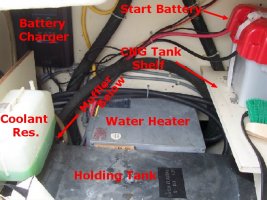ericson 34 starting battery
I too have a refer compressor on the shelf on top of the water heater and also a second refer compressor in the space under the port settee just forward of the sinks. I could squeeze a battery box next to the compressor on top of the water tank but then there is a long run of 1/0 cables going to the battery switch, although the new battery box would be very close to the charger, but that is relatively thin wire and low current.
My present plan is to mount a battery box as Bob Morrison did just on top of the shaft log wedged against the front edge of the fuel tank and strapped to the plywood wall of the existing battery box. I already have a dripless shaft seal so accessibility is not a problem and when that seal needs service, I would remove the battery for better access. Someone's comment about heat from the engine concerns me, does anyone think that is real problem, the battery will be in a poly battery box. Access to fill the battery is not great but hey it's a boat, nothing is easy but I can see and touch it so it is not impossible with some clean tubing. Does anyone else have any concerns about that mounting place, please let me know.
I plan to mount a Blue Seas ACR on the rear plywood wall on the engine compartment, , port side. The boat had a battery combiner, the old fashioned kind with diodes that the PO bypassed, probably due to the diode voltage drop but the new version using a relay does not have that problem. I will remove the old diode box and install the new relay version.
I also plan to keep the 1-2-all battery switch, I know the new Blue Seas on-off-combine switch is a better architecture but for now I think the 1-2-all is OK as long as I dont forget to change the battery settings when needed, I am pretty good about those things. Maybe at a later date, I will change the switch. But right now I need to get one refer compressor back working and see why the AC does not work. The PO was gadget happy but I hate to have expensive gadgets not working, hence my need for more battery capacity.
Again, thanks to all who responded.
Herb Friedman, SF Bay, CA




